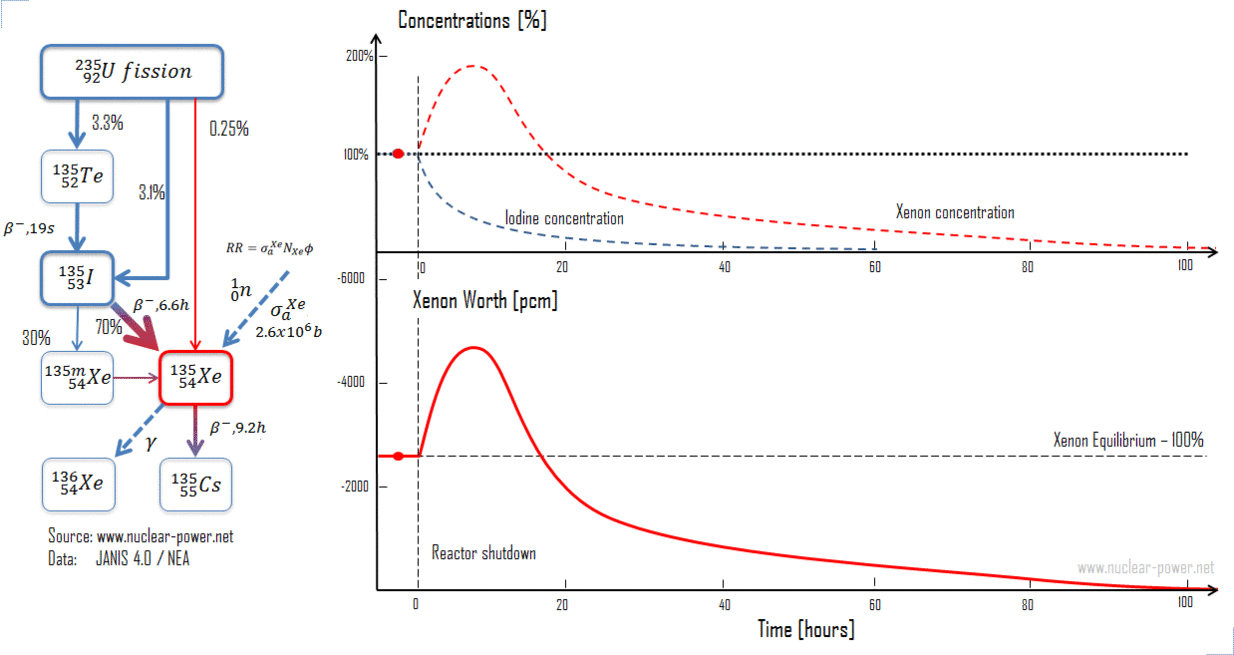However, with all control rods verified fully inserted by two independent means, it is unnecessary to account for a stuck rod in the SDM calculation. With any control rod not capable of being fully inserted, the reactivity worth of all control rods must be accounted for in the determination of SDM. SDM is usually defined for PWRs as well as for BWRs.
A shutdown margin is required to exist at all times, even when the reactor is critical. Let’s assume the SDM is 2%. The reactor can either be critical or safe subcritical (keff < 0.98). Subcriticality of about 0.99 with all rods inserted is not a safe subcritical condition.
During power operation, SDM is ensured by operating with the shutdown banks fully withdrawn and the control banks within the so-called “rod insertion limits” specified in the technical specifications. Suppose the operator wants to shut down the reactor from Hot Full Power – equilibrium xenon to Hot Zero Power – with xenon, for example, in the case of reactor SCRAM. In that case, he must insert negative reactivity to compensate for the power defect. If the power defect for PWRs is about 2500 pcm (about 4 βeff), the control rods must weigh more than 2500 pcm to achieve the subcritical condition. A shutdown margin in the range of one to five percent reactivity is typically required. Therefore to ensure the safe subcritical condition, the control rods must weigh more than 2500 pcm plus the value of SDM. The total weight of control rods is design specific value, but, for example, it may reach about 6000 to 9000 pcm.
When the reactor is in the shutdown and refueling modes, the SDM requirements are met by means of adjustments to the boron concentration.
SDM and Safety Analyses (PWRs)
The minimum required SDM is assumed as an initial condition in safety analyses that are started from subcritical states. For cold shutdown mode, the primary safety analysis that relies on the SDM limits is the analysis of the unintentional decrease in boron concentration in the reactor coolant system (only for PWRs), where unborated water is added the reactor coolant system (RCS) to increase core reactivity. This may be inadvertent due to operator error or system malfunction and cause an unwanted increase in reactivity and a decrease in shutdown margin. The required SDM defines the reactivity difference between an initial subcritical boron concentration and the corresponding critical boron concentration. The operator must stop this unplanned dilution before the shutdown margin is eliminated.
For PWRs, the most limiting accident for the SDM requirements is based on a main steam line break (MSLB) starting from subcritical states. The steamline break causes the steam pressure the saturation temperature in the steam generators to fall rapidly. As a result of the falling saturation temperature in the steam generators, the moderator temperature will rapidly decrease. The rapid moderator temperature drop causes a positive reactivity insertion. The amount of reactivity inserted also depends on the magnitude of the MTC, and therefore it must be limited. The typical values for lower limit are MTC = -80 pcm/°C, but it is a plant-specific value limited in technical specifications. This positive reactivity addition may cause criticality of the core even with all rods inserted. The required SDM defines the reactivity difference between an initial subcritical boron concentration and the corresponding critical boron concentration.
In addition to these accidents, the SDM requirement is also assumed in:
- Uncontrolled Control Rod Assembly Withdrawal from a Subcritical or Low Power Startup Condition
- The spectrum of Rod Ejection Accidents
